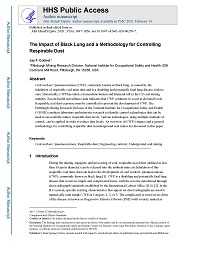Mining Publication: The Impact of Black Lung and a Methodology for Controlling Respirable Dust
Original creation date: December 2020
Authors: J Colinet
Coal workers’ pneumoconiosis (CWP), commonly known as black lung, is caused by the inhalation of respirable coal mine dust and is a disabling and potentially fatal lung disease with no cure. Historically, CWP has taken a tremendous human and financial toll in the US coal mining industry. Recent health surveillance data indicates that CWP continues to occur at elevated levels. Respirable coal dust exposure must be controlled to prevent the development of CWP. The Pittsburgh Mining Research Division of the National Institute for Occupational Safety and Health (NIOSH) conducts laboratory and mine-site research to identify control technologies that can be used to successfully reduce respirable dust levels. Various technologies, using multiple methods of control, can be applied in order to reduce dust levels. An overview of CWP’s impact and a general methodology for controlling respirable dust in underground coal mines are discussed in this paper.
